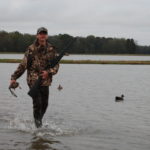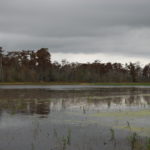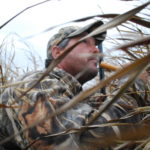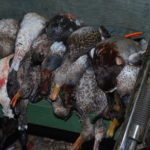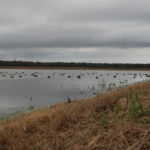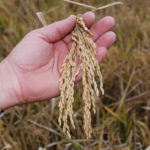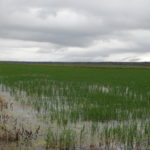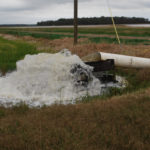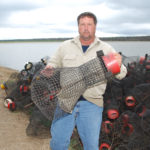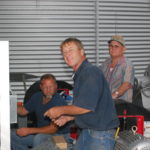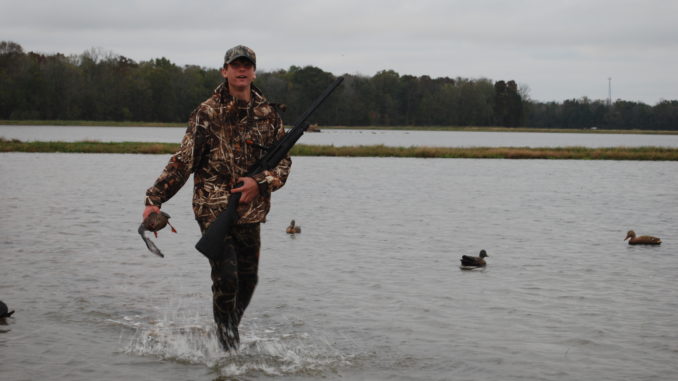
This family of farmers won a prestigious award for taking steps to make their land as attractive to ducks as possible.
Bulletin: The Earth’s human population just reached 7 billion people.
Bulletin: All of them want to eat.
With the exception of what comes from wildlife and wild fisheries, almost everything the Earth’s peoples eat and wear comes from agriculture. The United States is truly a land of plenty, where real hunger isn’t felt. Hunters, like other Americans, have full mouths and bellies.
Agriculture does displace some wildlife, while at the same time agricultural fields make up the largest component of wildlife habitat in the United States, where 70 percent of land ownership is in private hands. Fifty percent of the U.S. land base is managed as cropland, pasture and range.
The dependence of wildlife on agricultural land use is particularly acute in the Southeast, where over 90 percent of all land is privately owned.
“Wildlife populations rely on private land because there just isn’t enough public land,” says John Pitre, the Louisiana Wildlife Biologist with the Natural Resources Conservation Service (NRCS).
Jerry Holden, Jr., director of Conservation Programs for the South Atlantic Flyway for Ducks Unlimited (DU) agrees.
“The 7 billion people on Earth puts pressure on food and fiber supplies,” he said. “Considering that, we better find a way to foster wildlife from production agricultural systems.”
Some farmers, working through U.S. Government Farm Bill programs, are doing just that. Durand Farms, plunked down between St. Martinville and the western guide levee of the Atchafalaya Basin, is a sparkling example. The nearly 1,200-acre rice and crawfish operation, owned by Jeff, Greg and Conery (C.J.) Durand, was the recipient of a 2011 Ducks Unlimited Conservation Achievement Award.
DU presents six of the prestigious awards each year in the United States, only one of which goes to private citizens for conservation contributions. Durand Farms of Louisiana was that winner.
A trip to the farm finds the three brothers doing what farmers have to do too much of — mechanical work. Supervised by their dad Marin, they are wrestling with the electrical circuitry of their pressure-cure grain bin system. C.J., the quiet one, is lost deep in thought, with his nose buried in an electrical box. Jeff, at 52 the oldest of the trio and their unofficial spokesman, is assisting him.
Greg, apparently the designated tour guide, is wearing a huge, friendly grin. Away from the cluster of 10 huge bins (each of the pair of larger ones holds 11,000 162-pound barrels of rice), the farm is a crazy quilt of blue, brown and green.
Green patches are fields (ponds) managed strictly for crawfish production. The young, vibrant green rice plants will never produce seed heads, but rather have been planted for their stalks and leaves to provide forage for the crop of mudbugs.
Brown patches come in three flavors. Some are brown-topped, with green shoots coming on from the plant bases. These fields had a single crop of rice harvested earlier in the year and are now, in the fall, flooded for crawfish production.
The remaining two types of brown fields have been managed for two crops of rice and are not flooded at the moment. Some, with obvious machinery tracks through them, have been stripped of their second crop of rice for the year by tracked combines. The remainder, with heavily nodding heads of mature rice kernels, are awaiting harvest.
Blue patches with open water and no stands of vegetation are “resting.” Roughly one-fourth of the acreage of the farm is idle at any one time and not planted in crops for the year. These would ordinarily be dry, but are flooded with a thin sheet of water, because the acreage is enrolled in the NRCS Migratory Bird Habitat Initiative (MBHI).
Under MBHI, rice farmers are paid to flood land to provide habitat for migratory birds, not just ducks but smaller migratory shorebirds as well. The payments help to keep rice farmers in business and at the same time benefit wildlife.
“The magic of this [MBHI],” says DU’s Holden, “is that ducks are winning and [agricultural] producers are winning.”
Birds are in evidence everywhere on the farm. Ducks are there, of course, but so are gobs of small and medium shorebirds, song birds, hawks and even eagles.
Greg sweeps his arm over the landscape in describing it.
“Everything that looks like a pile of grass is a duck blind,” he says.
There seem like a lot of them — 26 to be exact.
The rice and crawfish farm is so attractive to ducks that the brothers lease hunting blinds to waterfowlers and have a waiting list. And, of course, they hunt as well. All three of them, and many of their extended family as well, are duck hunters.
In addition to participating in NMBI, Durand Farms participates in the NRCS Conservation Stewardship Program. Unlike programs that pay farmers to set aside land from farming production, this one offers payments to farmers who maintain a high level of conservation on their land and agree to adopt even higher levels of stewardship.
Following are other examples of what the brothers do at Durand Farms to benefit the environment, wildlife and ultimately sportsmen.
• Nutrient management. Rather than practice general fertilization, they monitor the farm’s soil through lab analyses to add fertilizers only to the level needed for crop production. As a result, less phosphorus and nitrogen travels into the surrounding ecosystem.
• Pesticide management. They personally go out into the fields and check what kinds of weeds are present and then specifically target those, rather than just use blanket herbicides. As hard as it is to believe, they even do a great deal of hand-weeding on the huge farm. The same targeted approach is done with the use of insecticides and fungicides.
• Precision land leveling. Using laser-leveling equipment results in flat, level fields, which in turn conserves water by allowing for uniform flooding depths.
• No-till and minimum-till planting. Many farmers used to and still do work their farmland heavily by plowing and disking. The Durands’ approach results in less sediment run-off, improves organic matter levels in the soil and because less fuel is used, reduces their farm’s carbon footprint.
• Underground water pipelines and grade stabilization structures. The brothers move a lot of water for rice and crawfish farming. Their water movement system is efficient and reduces erosion and sediment loss on the outflow.
• Diesel to electric. An energy audit showed that the change-over reduced energy consumption by pumps on the farm by 58 percent.
• Water source. Using surface water from canals and bayous rather than ground water reduces energy use and recycles sediment from canals (that was lost by surrounding cane farms) back onto the land.
• Tracks and floater tires. Using tracks and balloon-like floater tires on their field equipment significantly reduces soil compaction.
The Durands are not strangers to being recognized for their conservation and farming practices. In 2009, they were presented with the Outstanding Master Farmer Award from the LSU AgCenter. The next year, they were named Rice Farmer of the Year by Rice Farming magazine and Syngenta.
Holden calls them “very progressive producers,” but notes that as good as they are, “it is about the whole rice-crawfish complex.
“Rice is really good for ducks,” he said. “But it is also a beleaguered resource in southwestern Louisiana. We are at 55 percent of our top production in Louisiana and Texas.”
In Louisiana, part of the problem is saltwater intrusion into sources of fresh water for rice irrigation. In Texas, it is water availability. Water is worth so much more for urban use.
“Ducks Unlimited has a strong interest in keeping rice farmers in the South,” Holden says. “The North American Waterfowl Management Plan lays out waterfowl population objectives, and DU works to meet those objectives. Louisiana is supposed to winter 9.2 million waterfowl. That’s a lot of little mouths to feed.
“The vast majority of the Gulf coastal prairie and marsh is in private ownership. We have lost 1.2 million acres of high-quality habitat to water. That’s one-third of what was there. Agriculture has always been important in the coastal prairie, but now with habitat loss, it is critical for waterfowl, not to mention shore birds. Rice production in South Louisiana is very, very good for waterfowl and water birds.”
Holden calls the creation of MBHI a partnership between DU and NRCS and notes that perhaps together they can reduce “input costs a little” for rice farmers and increase their efficiency.
“The bottom line is that it [MBHI] is very good for ducks,” he says.
Pitre with NRCS agrees strongly, almost echoing much of what Holden says. NRCS’s major vehicles, explains Pitre, are technical assistance and “serious dollars” for landowners for conservation.
“We know that wet agriculture, rice and crawfish, supports tremendous numbers of wildlife,” he says. “If we can tweak things a little bit with things like MBHI, we can greatly enhance habitat for a wide array of species. The result should both be wildlife-friendly and helping [agricultural] producers survive.
“There are two big things in wildlife management today. First, if society wants wildlife, they will have to pay landowners for wildlife services. In the past, they [landowners] provided this service for free. They received no payment for the great blue herons and dowitchers that used their property, to the benefit of society.
“The other is how invasive species are becoming huge threat factors to native wildlife. Only by building big partnerships between private landowners, state and federal agencies, universities and nongovernmental conservation organizations can this threat be met.”
Pitre ticks of the list of wildlife-habitat restoration programs and initiatives in which NRCS is currently involved: the Wetlands Reserve Program, the Wildlife Habitat Incentive Program, the Environmental Quality Incentives Program, the Grassland Reserve Program, the Conservation Stewardship Program, the Migratory Bird Habitat Initiative and consultatively, the Conservation Reserve Program.
A final one that he emphasizes is the Working Wetlands Initiative.
“This one would have never happened without Jeff Durand, and he gets nothing from it,” said Pitre. “He’s a steward of the land and level-headed.
“When he speaks, people listen, both in the rice industry and the conservation community.”
The night before the hunt, over supper in a local restaurant, Jeff responds in his soft-spoken way to the question about why Durand Farms practices conservation-minded agriculture.
“It’s the practical thing to do,” he said. “It makes business sense, and it makes sense to take care of the natural resources that we all depend on for our livelihoods, our recreation and our health.
“Sportsmen need to see rice farmers stay in business.”
